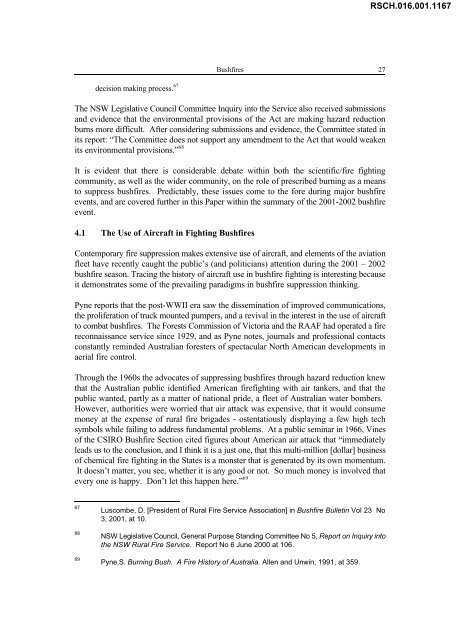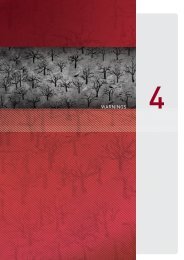RSCH.016.001.1136 - 2009 Victorian Bushfires Royal Commission
RSCH.016.001.1136 - 2009 Victorian Bushfires Royal Commission
RSCH.016.001.1136 - 2009 Victorian Bushfires Royal Commission
You also want an ePaper? Increase the reach of your titles
YUMPU automatically turns print PDFs into web optimized ePapers that Google loves.
RSCH.016.001.1167<br />
<strong>Bushfires</strong> 27<br />
decision making process. 67<br />
The NSW Legislative Council Committee Inquiry into the Service also received submissions<br />
and evidence that the environmental provisions of the Act are making hazard reduction<br />
burns more difficult. After considering submissions and evidence, the Committee stated in<br />
its report: “The Committee does not support any amendment to the Act that would weaken<br />
its environmental provisions.” 68<br />
It is evident that there is considerable debate within both the scientific/fire fighting<br />
community, as well as the wider community, on the role of prescribed burning as a means<br />
to suppress bushfires. Predictably, these issues come to the fore during major bushfire<br />
events, and are covered further in this Paper within the summary of the 2001-2002 bushfire<br />
event.<br />
4.1 The Use of Aircraft in Fighting <strong>Bushfires</strong><br />
Contemporary fire suppression makes extensive use of aircraft, and elements of the aviation<br />
fleet have recently caught the public’s (and politicians) attention during the 2001 – 2002<br />
bushfire season. Tracing the history of aircraft use in bushfire fighting is interesting because<br />
it demonstrates some of the prevailing paradigms in bushfire suppression thinking.<br />
Pyne reports that the post-WWII era saw the dissemination of improved communications,<br />
the proliferation of truck mounted pumpers, and a revival in the interest in the use of aircraft<br />
to combat bushfires. The Forests <strong>Commission</strong> of Victoria and the RAAF had operated a fire<br />
reconnaissance service since 1929, and as Pyne notes, journals and professional contacts<br />
constantly reminded Australian foresters of spectacular North American developments in<br />
aerial fire control.<br />
Through the 1960s the advocates of suppressing bushfires through hazard reduction knew<br />
that the Australian public identified American firefighting with air tankers, and that the<br />
public wanted, partly as a matter of national pride, a fleet of Australian water bombers.<br />
However, authorities were worried that air attack was expensive, that it would consume<br />
money at the expense of rural fire brigades - ostentatiously displaying a few high tech<br />
symbols while failing to address fundamental problems. At a public seminar in 1966, Vines<br />
of the CSIRO Bushfire Section cited figures about American air attack that “immediately<br />
leads us to the conclusion, and I think it is a just one, that this multi-million [dollar] business<br />
of chemical fire fighting in the States is a monster that is generated by its own momentum.<br />
It doesn’t matter, you see, whether it is any good or not. So much money is involved that<br />
every one is happy. Don’t let this happen here.” 69<br />
67<br />
68<br />
69<br />
Luscombe, D. [President of Rural Fire Service Association] in Bushfire Bulletin Vol 23 No<br />
3, 2001, at 10.<br />
NSW Legislative Council, General Purpose Standing Committee No 5, Report on Inquiry into<br />
the NSW Rural Fire Service. Report No 6 June 2000 at 106.<br />
Pyne,S. Burning Bush. A Fire History of Australia. Allen and Unwin, 1991, at 359.
















